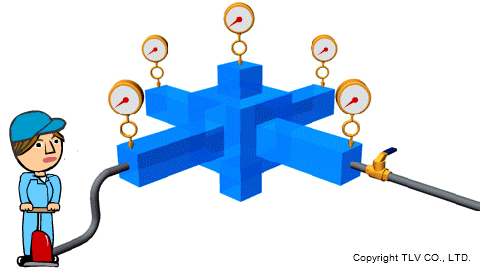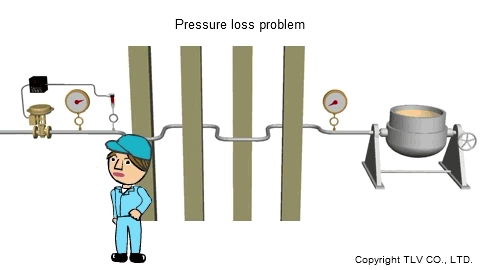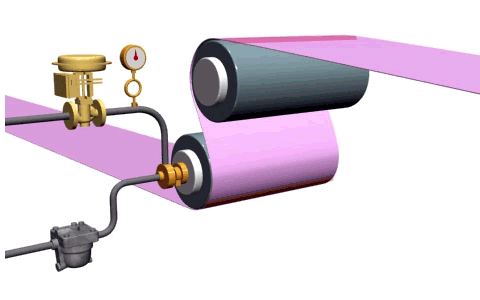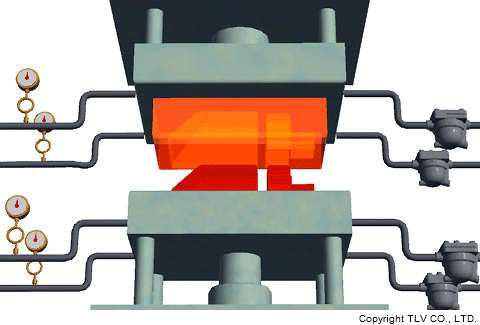- Home
- Steam Resources
- Steam Theory
- Steam Pressure Control
Steam Control
Steam Pressure Control
Why Measure Pressure in Heating Applications?
In Problems With Temperature Control, we introduced the problems that make measuring the temperature of a product difficult, and explained how they affect the temperature control process.
In this article, we will consider a method of avoiding these difficult temperature measurements. Usually, the steam used in conventional heating applications is saturated steam. One important feature of saturated steam is that its temperature is always determined by its pressure. Steam heating applications make use of this feature by adjusting the pressure of steam to control its temperature.
In other words, you can set saturated steam to the required temperature without measuring its temperature.
Precautions Regarding Pressure Measurement
One concern for steam users may be whether measuring the pressure of steam comes with the same problems as with measuring temperature.
In a closed space, pressure is the same no matter where it is measured, and gauges show changes in pressure instantaneously. Therefore, problems that come with temperature measurement, such as different temperature readings depending on the measurement location and measurement lags, are rarely encountered when measuring pressure. As a result, by controlling the pressure of the steam, you can precisely control its temperature.
However, users must be careful to do the following when controlling the pressure of saturated steam:
- Ensure that the steam chamber of the heat exchanger is filled only with steam
- Prevent pressure loss
Particularly, the first point is a prerequisite, so condensate that forms within the steam chamber should be drained promptly. Also, if there are gases other than steam (such as air) present in the chamber, the steam will not reach the desired saturation temperature due to the problem of partial pressure, so ensure that other gases do not enter the chamber. This problem is explained in detail in Temperature Problems Caused by Air.
In the second point, if there is a large amount of resistance beyond the point where the pressure is measured, the pressure can drop greatly at the equipment, causing the steam temperature to also drop. Users need to pay close attention to these points.

In an enclosed space, pressure does not differ by location, and gauges show changes in pressure instantaneously.

If there is a loss in pressure, the steam temperature decreases.
When using steam in heating applications, be aware of pressure loss. When the pressure of steam drops due to resistance from long, narrow, or bends in the piping, the temperature drops relative to pressure drop. It is thus necessary to devise a way of countering this problem, such as by controlling the pressure near the equipment.
Equipment In Which Pressure Can Be Effectively Controlled
Next, let's look at examples of specific equipment in which steam pressure is controlled.
It is very difficult to directly measure the temperature of a thin sheet of material in a process where the material is continuously moving. However, if the relationship between the heating load (in this case, the sheet width, its thickness, the amount of specific heat, the moisture content in the steam, the winding speed of the equipment, etc.) and the heat transfer area (the roll diameter, contact angle with the roll, etc.) is constant, you can heat uniformly by supplying a heat source with a constant temperature. Once conditions have been set and adjusted appropriately, for example during trial operation, it becomes easy to control steam pressure and achieve stable production.
If the steam pressure can be fixed during operation, you can control it with pressure-reducing valves alone, and do not need other instrumentation such as temperature control valves, control valves, or temperature sensors. This makes for a simple and reliable equipment configuration.
In addition to the roll-type heat exchanger mentioned above, other equipment/processes in which steam is controlled include: autoclaves such as vulcanizers and sterilizers, in which the product can be enclosed in a pressure vessel; or resin moulding press machines, in which it is difficult to measure the temperature of the heat-transfer surface and the product once the press is closed.
In addition to the above, there are also other temperature-controlled processes that could be controlled using pressure.

Measuring temperature on a cylinder dryer line
Since the heat transfer surface rotates and the product moves continuously, it is difficult to measure the temperature.

Measuring temperature within a die press
It is difficult to measure during heating because the heat-transfer surface and the product are not exposed.
In the next article Comparing Steam and Hot Water Heating, we will look at two heating mechanisms and their applications.

